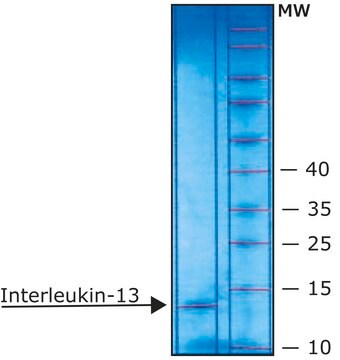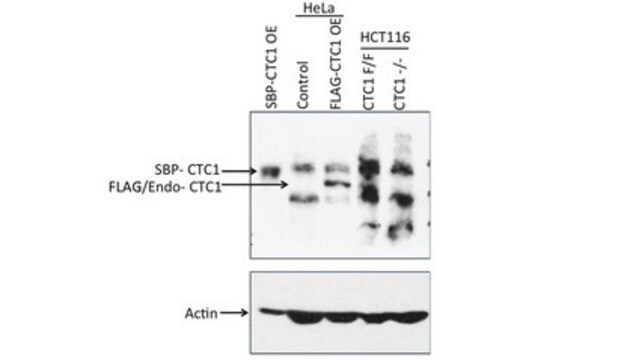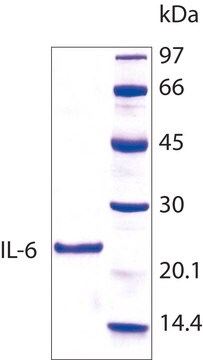SRP3091
IL-31 human
recombinant, expressed in E. coli, ≥98% (SDS-PAGE), ≥98% (HPLC), suitable for cell culture
Sign Into View Organizational & Contract Pricing
All Photos(1)
About This Item
UNSPSC Code:
12352202
NACRES:
NA.32
Recommended Products
biological source
human
recombinant
expressed in E. coli
assay
≥98% (HPLC)
≥98% (SDS-PAGE)
form
lyophilized
mol wt
15.8 kDa
packaging
pkg of 10 μg
technique(s)
cell culture | mammalian: suitable
impurities
<0.1 EU/μg endotoxin, tested
color
white to off-white
UniProt accession no.
shipped in
wet ice
storage temp.
−20°C
Gene Information
human ... IL31(386653)
Related Categories
General description
IL-31 (interleukin 31) is a T-cell expressed four helix bundle cytokine that functions as a ligand for a heterodimeric receptor composed of IL-31 receptor A (IL-31RA) and oncostatin M receptor (OSMR). The latter is expressed in epithelial cells and keratinocytes. IL-31 is a member of the gp130/IL-6 (glycoprotein 130) cytokine family. This protein is released by CD4+T cells, and is activated by Th2 (T-helper) cells, peripheral blood and skin-homing CD45RO+ CLA+ (cutaneous lymphocyte-associated antigen-positive) T cells and MCs (mast cells).
Recombinant IL-31 is a 15.8kDa protein containing 141 amino acid residues.
Recombinant IL-31 is a 15.8kDa protein containing 141 amino acid residues.
Biochem/physiol Actions
IL-31 (interleukin 31) is implicated in the pathogenesis of inflammatory disorders such as alopecia, atopic dermatitis, itching, airway hypersensitivity, inflammatory bowel disease, and hepatitis B related liver failure. It is a specific and sensitive marker for tuberculous pleurisy, and is capable of differentiating it from malignant pleural effusion. In humans, this cytokine shows significant elevated expression in pruritic, such as atopic dermatitis, but not in non-pruritic, such as psoriasis, forms of chronic skin inflammation. IL-31 is also implicated in the pathogenesis of chronic spontaneous urticaria, prurigo nodularis, and primary cutaneous lymphomas. Variants in this gene might be linked with the development of mastocytosis and the induction of pruritus in mastocytosis patients.
Sequence
SHTLPVRLLR PSDDVQKIVE ELQSLSKMLL KDVEEEKGVL VSQNYTLPCL SPDAQPPNNI HSPAIRAYLK TIRQLDNKSV IDEIIEHLDK LIFQDAPETN ISVPTDTHEC KRFILTISQQ FSECMDLALK SLTSGAQQAT T
Physical form
Lyophilized from 10 mM Sodium Phosphate, pH 7.5.
Reconstitution
Centrifuge the vial prior to opening. Reconstitute in water to a concentration of 0.1-1.0 mg/ml. Do not vortex. This solution can be stored at 2-8°C for up to 1 week. For extended storage, it is recommended to further dilute in a buffer containing a carrier protein (example 0.1% BSA) and store in working aliquots at -20°C to -80°C.
Storage Class
11 - Combustible Solids
wgk_germany
WGK 3
flash_point_f
Not applicable
flash_point_c
Not applicable
Certificates of Analysis (COA)
Search for Certificates of Analysis (COA) by entering the products Lot/Batch Number. Lot and Batch Numbers can be found on a product’s label following the words ‘Lot’ or ‘Batch’.
Already Own This Product?
Find documentation for the products that you have recently purchased in the Document Library.
Interleukin-31 Polymorphisms and Serum IL-31 Level in Patients with Mastocytosis: Correlation with Clinical Presen-tation and Pruritus.
Lange M et al
Acta Dermato-Venereologica, 97(1), 47-53 (2017)
Potential diagnostic value of serum/pleural fluid IL-31 levels for tuberculous pleural effusion.
Gao Y et al
Scientific Reports, 6, 20607-20607 (2016)
IL-31: a new link between T cells and pruritus in atopic skin inflammation.
Sonkoly E et al
The Journal of Allergy and Clinical Immunology, 117(2), 411-417 (2006)
Lia Ginaldi et al.
BMC immunology, 16, 60-60 (2015-10-10)
Several inflammatory cytokines play a key part in the induction of osteoporosis. Until now, involvement of the Th2 cytokine interleukin-31 (IL-31) in osteoporosis hadn't yet been studied. IL-31 is a proinflammatory cytokine mediating multiple immune functions, whose involvement in a
Stacey R Dillon et al.
Nature immunology, 5(7), 752-760 (2004-06-09)
T cell-derived cytokines are important in the development of an effective immune response, but when dysregulated they can promote disease. Here we identify a four-helix bundle cytokine we have called interleukin 31 (IL-31), which is preferentially produced by T helper
Our team of scientists has experience in all areas of research including Life Science, Material Science, Chemical Synthesis, Chromatography, Analytical and many others.
Contact Technical Service



